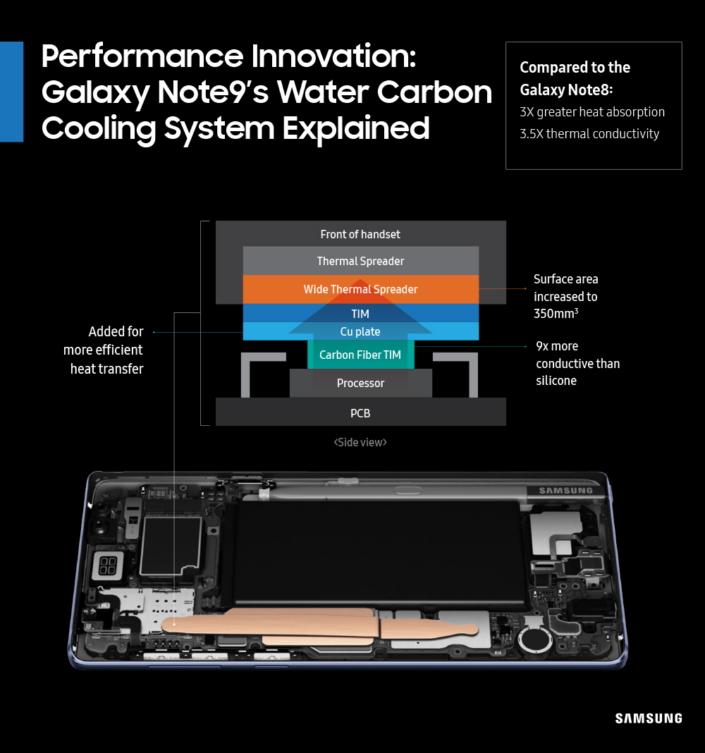The all new Super-Note, Galaxy Note9 was perhaps underrated by many considering it as an incremental upgrade over its predecessor. But, as in fact it’s a drastic evolutionary upgrade though devoid of any radical revolution or design breakthrough. Despite, Samsung focused on perfecting at all those areas where it was already a leader. Upgraded display, optimized software, AI powered Camera, re-invented S-Pen and a new cooling system which Samsung fondly monikered as the new – Water-Carbon Cooling System.

All those improvements mentioned above, apart from the Water-Carbon Cooling System were more or less accepted and appreciated by the tech watch-dogs. However, the newly introduced cooling system on the Note9 was considered as a gimmick and just another marketing ploy. May be for that reason, Samsung has now explained its motive and the idea behind the new Water-Carbon Cooling System, literally conveying us to not to take it lightly.
Improving The Water Cooling System Introduced With the Galaxy S7
The Galaxy S7/S7 Edge is undoubtedly among Samsung’s best ever creations. Similar to how the Galaxy Note9 is to the Galaxy Note8, you know it, the Galaxy S7/S7 Edge were identical to its predecessors the Galaxy S6/S6 Edge in terms of design. Despite, the minor improvements and irradication of the flaws that were present on the Galaxy S6/Edge made the Galaxy S7 Edge the best smartphone then. It’s with the Galaxy S7/S7 Edge when Samsung firstly introduced its custom cooling system known as Water Cooling System.
The cooling system on Galaxy S7s used a porous thermal spreader filled with water, which absorbed the heat and turned into steam and then carried the heat away through a pipe. Once the heat dissipated, the steam condensed into water again. And, Samsung entitles the system as the blueprint for the Water Carbon Cooling system in the Galaxy Note9. All to make it bigger and more efficient such that the device with massive 4000mAH battery can dissipate heat with much ease than before.
Improvements
The cooling system since the S7s is nearly perfect and of good productivity. And, improving a thing which is already near to perfect is really a great challenge for Samsung. The South-Koran giant wanted to improve the original system, which was thin and used two Thermal Interface Materials (TIM), one made of highly conductive carbon fiber, to transfer heat away from the processor.
With the wider thermal spreader and enhanced Carbon Fiber interface, the cooling system conducts and transmits heat efficiently to the surface of the device, allowing the Galaxy Note9 to operate at peak performance consistently. When compared to the Galaxy Note8, the upgraded cooling system’s heat absorption is three times greater and the thermal conductivity is 3.5 times higher.
The immediate and efficient solution that popped-up on Samsung engineers was to introduce copper between the two TIMs, making it possible to transfer more heat between the two materials for more efficient heat dissipation. Note that Copper is a good-conductor of heat and available in abundance and cheap. Since heat dissipation is directly proportional to the surface area of the object, as a further improvement, they employed wider thermal spreading pipe, coming in at 350mm3 compared to the Galaxy S9’s 95mm3.
Outcome
As its result, the new improved Water Carbon Cooling system came into existence with the standard Water Cooling System as scrap. Profit – the Galaxy Note 9 is capable to effectively manage heat generated from its powerful processor. Theoretically, the upgraded cooling system’s heat absorption is three times greater and the thermal conductivity is 3.5 times higher than the Note 8.

